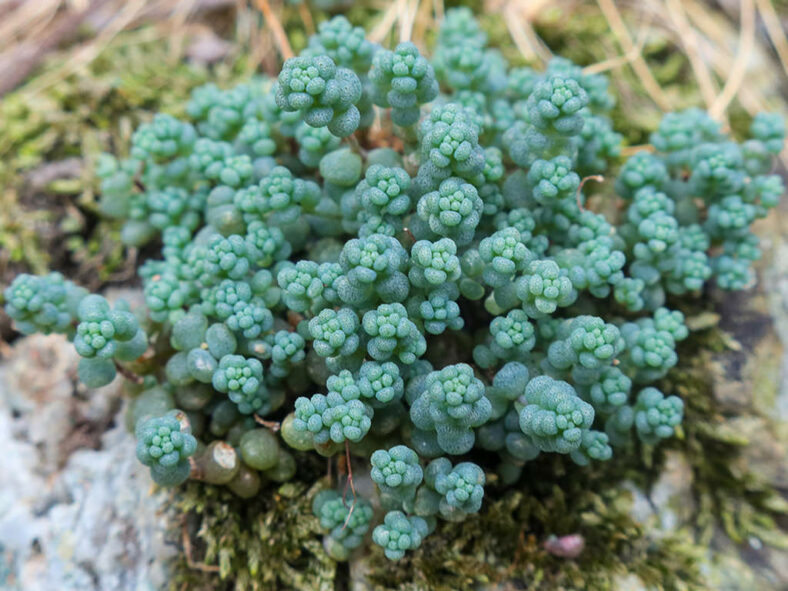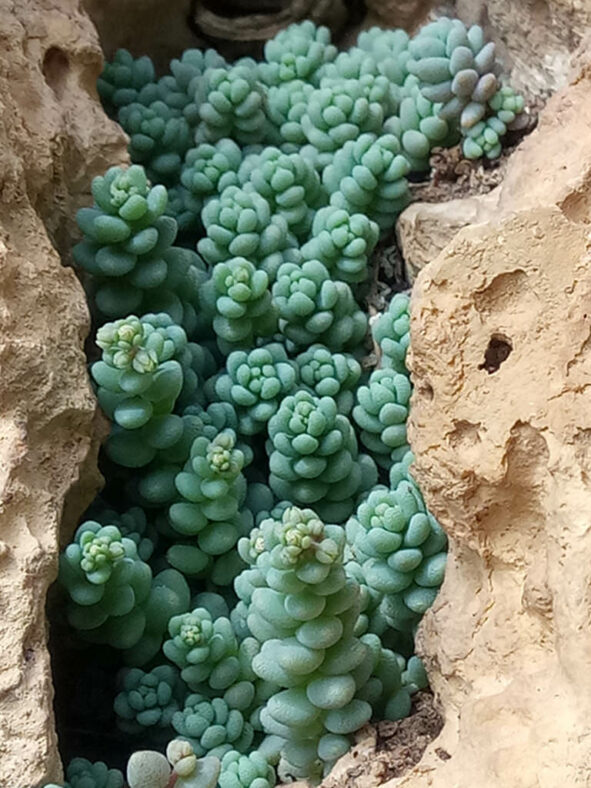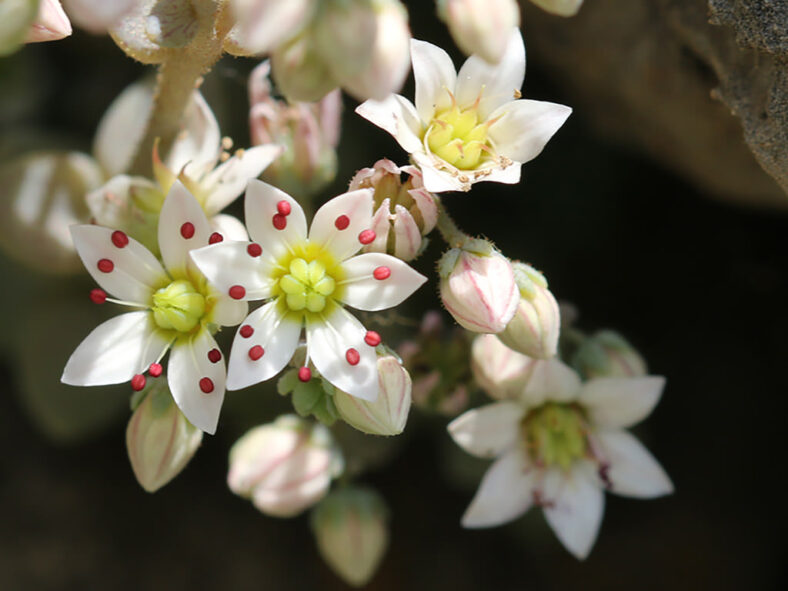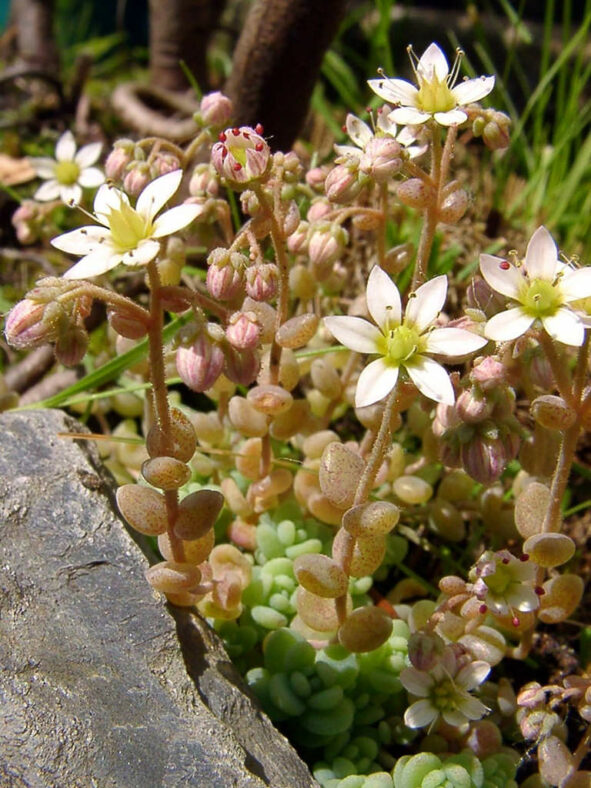Sedum dasyphyllum is a cold-hardy ground cover that adds color and life to your outdoor space throughout the year. It is also easy to grow in containers.
Scientific Name
Sedum dasyphyllum L.
Common Name(s)
Blue Tears Sedum, Corsican Stonecrop, Thick-leaved Stonecrop
Synonym(s)
Leucosedum dasyphyllum, Oreosedum dasyphyllum, Sedum granulatum, Sedum dasyphyllum subsp. dasyphyllum
Scientific Classification
Family: Crassulaceae
Subfamily: Sempervivoideae
Tribe: Sedeae
Genus: Sedum
Etymology
The specific epithet "dasyphyllum" (pronounced "das-ee-FIL-um") means "having dense, shaggy leaves; dasyphyllous" and refers to the leaves of this species covered with short, soft hairs.
Origin
Sedum dasyphyllum is native to southern, central, and south-eastern Europe, Turkey (Anatolia), the western Mediterranean Region, and North Africa. It usually grows among the rocks at elevations ranging from sea level to 8,200 feet (2,500 m).
Description
Sedum dasyphyllum is a mat-forming succulent with short, highly branched stems that bear small, ovoid to subglobose leaves. It can grow up to 6 inches (15 cm) tall, including inflorescences. The leaves are thick, fleshy, glaucous, and smooth or covered with fine, gland-bearing hairs. When stressed by drought or cold conditions, they take on a pink or purple tinge. The leaves are densely packed along the stems and can measure up to 0.3 inches (0.7 cm) in length.
In the summer, Sedum dasyphyllum produces small, star-shaped flowers on short, slender stalks with terminal branches. The flowers have sepals the same colors as the leaves, along with white petals that often have a red keel or a pinkish hue and red anthers.

Subspecies of Sedum dasyphyllum
- Sedum dasyphyllum subsp. dasyphyllum
- Sedum dasyphyllum subsp. granatense
- Sedum dasyphyllum subsp. oblongifolium
Cultivars of Sedum dasyphyllum
- Sedum dasyphyllum 'Himalayan Skies'
- Sedum dasyphyllum 'Lilac Mound'
- Sedum dasyphyllum 'Major'
- Sedum dasyphyllum 'Minor'
How to Grow and Care for Sedum dasyphyllum
Light: Sufficient light is essential for growing a healthy plant. Sedum dasyphyllum grows best in locations where it can enjoy the full sun for at least six hours daily, but it will tolerate some shade. Place the plant near a sunny window or use artificial lights when growing indoors.
Soil: This plant does not tolerate waterlogged soil, so proper drainage is essential to prevent root rot. You can use a commercially available succulent mix or create your own.
Temperature: Sedum dasyphyllum is well-tolerant of heat and low temperatures. It grows best in USDA Plant Hardiness Zones 4a to 9b, with average minimum winter temperatures ranging from -30°F to 30°F (-34.4°C to -1.1°C).
Watering: From spring through fall, water thoroughly and wait for the soil to dry out before watering again. During the winter, water the plant just enough to keep it from shriveling. When watering, avoid wetting the leaves, stems, and flowers.
Fertilizing: Feed a water-soluble fertilizer diluted to half the recommended strength during the growing season. However, feeding is unnecessary if you provide the plant with fresh soil annually.
Repotting: When Sedum dasyphyllum outgrows its current pot, repot it into a larger one during the spring. Ensure the soil is dry before beginning the repotting process.
Propagation: Sedum dasyphyllum can be propagated easily by taking leaf or stem cuttings during the growing season or by sowing seeds in spring or summer.
Learn more at How to Grow and Care for Sedum.
Toxicity of Sedum dasyphyllum
Sedum dasyphyllum is not listed as toxic for people, but it can be mildly toxic to pets and children.
Links
- Back to genus Sedum
- Succupedia: Browse succulents by Scientific Name, Common Name, Genus, Family, USDA Hardiness Zone, Origin, or cacti by Genus
Photo Gallery
Click on a photo to see a larger version.


